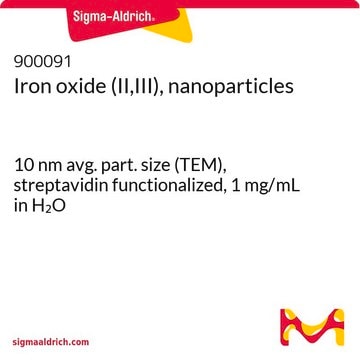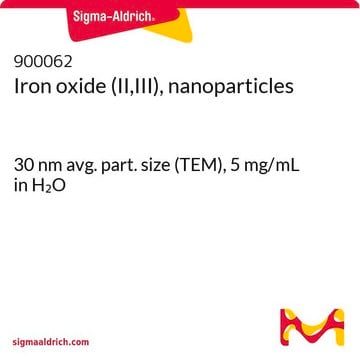900148
Iron oxide (II,III), nanoparticles
30 nm avg. part. size (TEM), streptavidin functionalized, 1 mg/mL in H2O
About This Item
Prodotti consigliati
Forma fisica
dispersion
nanoparticles
Livello qualitativo
Confezionamento
pkg of 1 mL
Condizioni di stoccaggio
do not freeze
Concentrazione
1 mg/mL in H2O
Dimens. media delle particelle
30 nm (TEM)
Gruppo funzionale
streptavidin
Temperatura di conservazione
2-8°C
Cerchi prodotti simili? Visita Guida al confronto tra prodotti
Categorie correlate
Descrizione generale
Applicazioni
Note legali
Codice della classe di stoccaggio
12 - Non Combustible Liquids
Classe di pericolosità dell'acqua (WGK)
WGK 2
Punto d’infiammabilità (°F)
Not applicable
Punto d’infiammabilità (°C)
Not applicable
Certificati d'analisi (COA)
Cerca il Certificati d'analisi (COA) digitando il numero di lotto/batch corrispondente. I numeri di lotto o di batch sono stampati sull'etichetta dei prodotti dopo la parola ‘Lotto’ o ‘Batch’.
Possiedi già questo prodotto?
I documenti relativi ai prodotti acquistati recentemente sono disponibili nell’Archivio dei documenti.
I clienti hanno visto anche
Articoli
Professor Hui Mao explores the use of superparamagnetic iron oxide nanoparticles (INOPs) that offer an alternate contrast-enhancing mechanism.
Prof. Yadong Yin discusses various synthesis methods of magnetite nanocrystals and their applications in different fields.
Il team dei nostri ricercatori vanta grande esperienza in tutte le aree della ricerca quali Life Science, scienza dei materiali, sintesi chimica, cromatografia, discipline analitiche, ecc..
Contatta l'Assistenza Tecnica.







